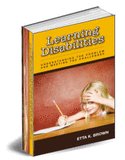|
VISUAL PROCESSING STRATEGIESEffective visual processing strategies are classroom modifications dictated by the specific needs of the child. No two children share the same set of strengths or areas of weakness, so no two children will benefit from the same strategy. An effective intervention is one that utilizes a child's strengths in order to build on the specific areas in need of development. Visual processing strategies need to be tried and evaluated, and new techniques tried until by trial and error you find what works. The design of strategies and intervention is a dynamic and ever changing process. Although this may sound overwhelming initially, it is important to remember that the process of finding successful interventions becomes easier with time as the child's learning style, and abilities are more carefully observed. Children are Good StrategizersThe very best visual processing strategies are those that the child chooses for himself. Take note of where the child places his book to read, if it is not straight in front of him or is tilted at an angle, take this as a sign that he is having difficulty, and leave the book where he places it. Very often teachers and parents fret over what to do next. It is heartily recommended that you consult with the child. The child knows best what he is experiencing, and can figure ways to modify the situation for himself. Offer him work with two sizes of print. Ask him which he prefers. Sometimes color plays a role in vision, ask him if he likes his work on light blue or cream colored paper. He needs help procuring supplies and the things that he thinks might work. That is where the adult comes in. Helping him to modify his world so that he can deal effectively with it until you are able to get a thorough visual examination will pay big benefits immediately. When you find out exactly what the problem is you will be better able to find an intervention that works.
The Golden Rule of Visual Processing StrategiesThe universal rule, for children exhibiting difficulties with visual processing disorders is to give them lots of breaks. Never allow them to become overly fatigued from visual tasks. Fatigue will bring about an immediate onslaught of oppositional behavior, and the fatigue has the potential of during further damage to an already immature visual system. In some cases, the ability to stay visually focused can be as short as two minutes in younger children, and up to ten minutes or fifteen minutes depending upon age and level of maturation. Carefully observe the time the child is able to stay focused and break things down into little chucks that they can complete in that amount of time (do two math problems instead of five). This is also a good idea when assigning homework. An excellent visual processing strategy is to have the child do something physical during his breaks like walking around the room or going to the pencil sharpener. The physical activity will jump start their nervous system, and they will be able to concentrate for another short period of time. Ever wonder why kids sharpen their pencils so much. They are giving themselves a time out from the visual task! Sensori-motor problems benefit from short breaks also. Plan a project of meaningful activities for them to do during these very necessary breaks. Find their area of strength and emphasize that. If they have artistic talent, plan a mural. Every child has something that they do well. Find that strength and keep them busy doing it. Keep visual tasks to a minimum. Put their books on tape and let them listen to a book. The objective is to make learning pleasant and prevent damage to the child’s self-concept. The damage to the psyche of learning handicapped children is immeasurable and can last a life time. Protect the child from failure.
Gross muscle movement is the key strategy for sensory motor integration and visual processing disorders.
|





